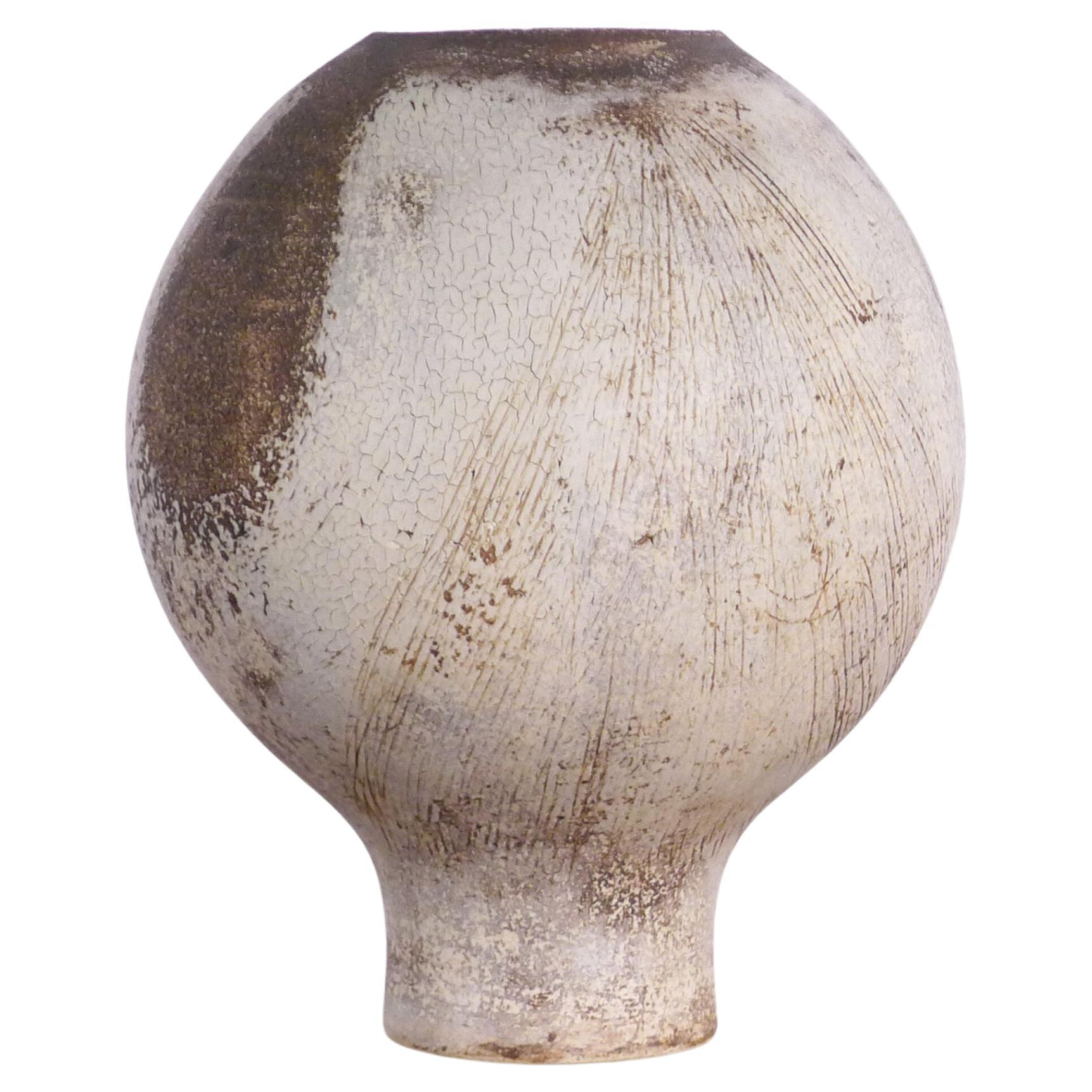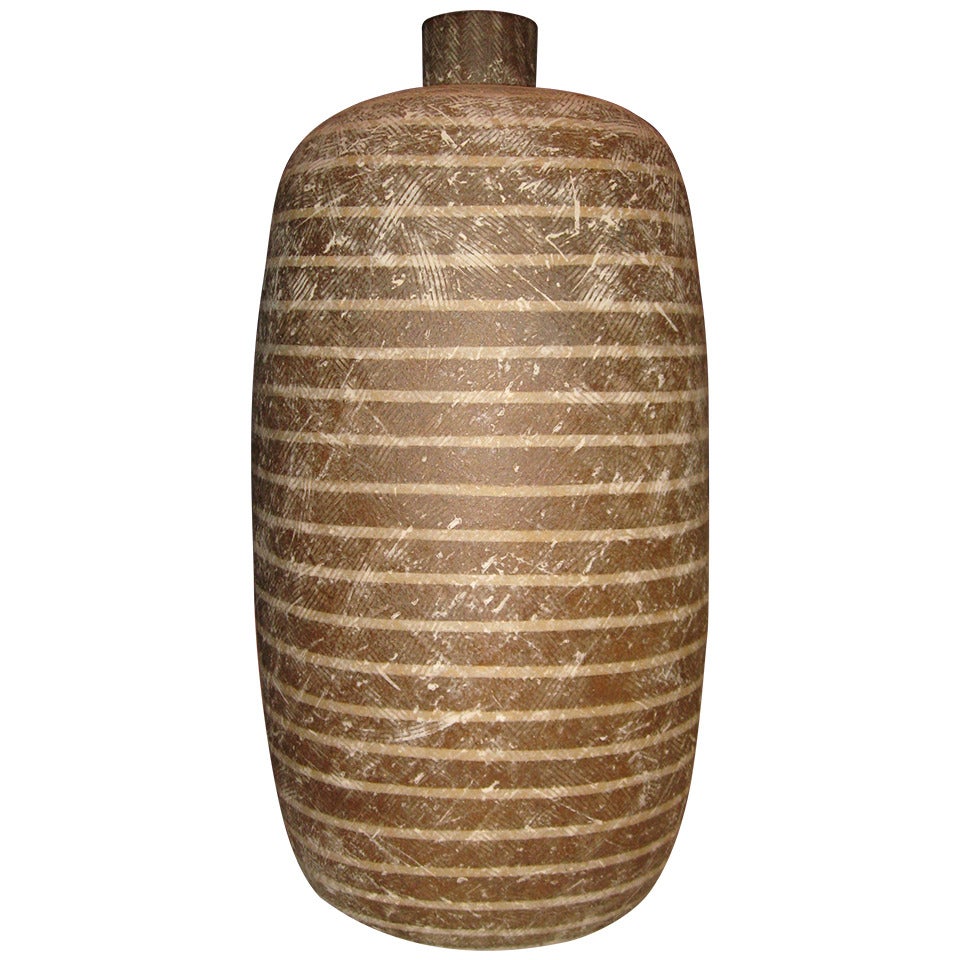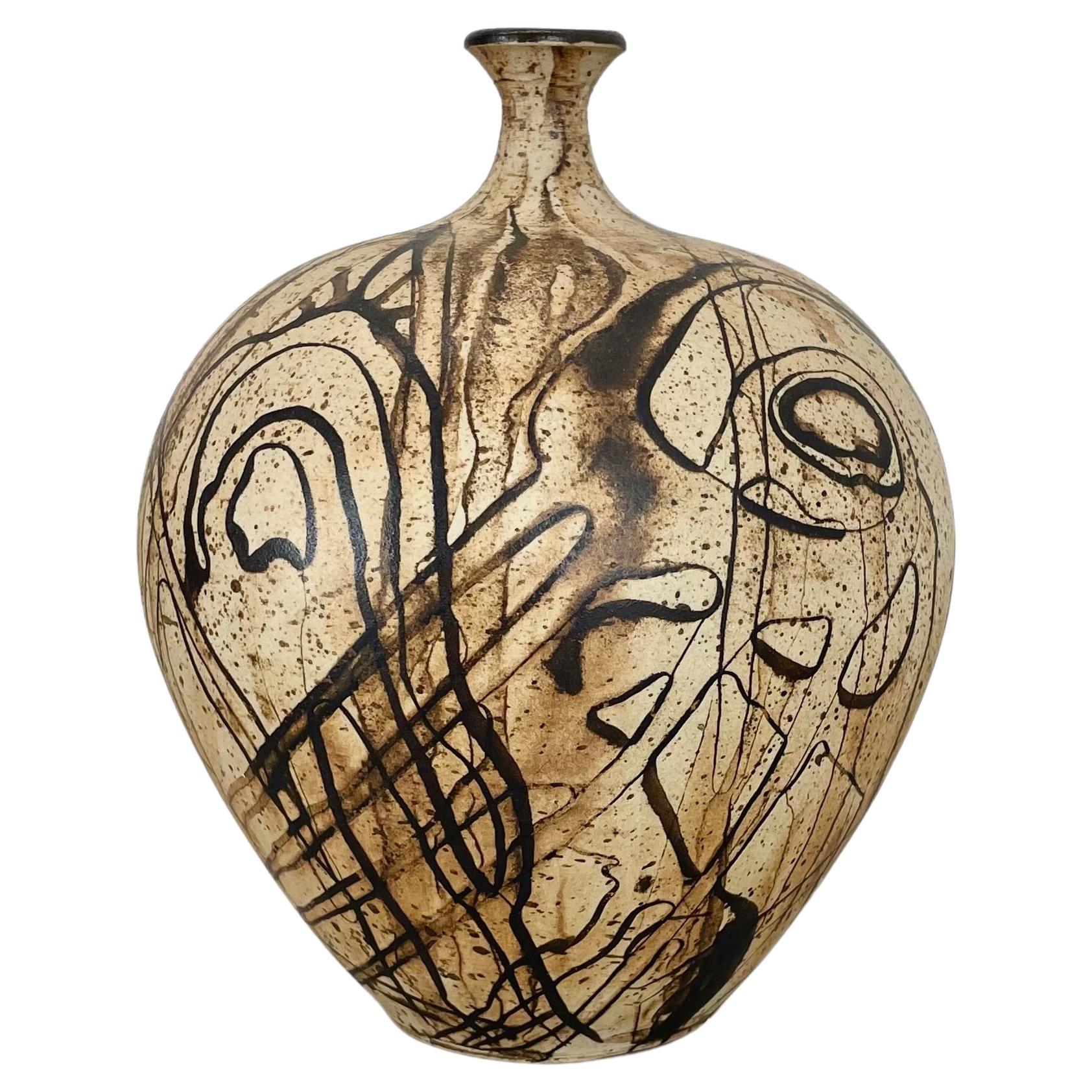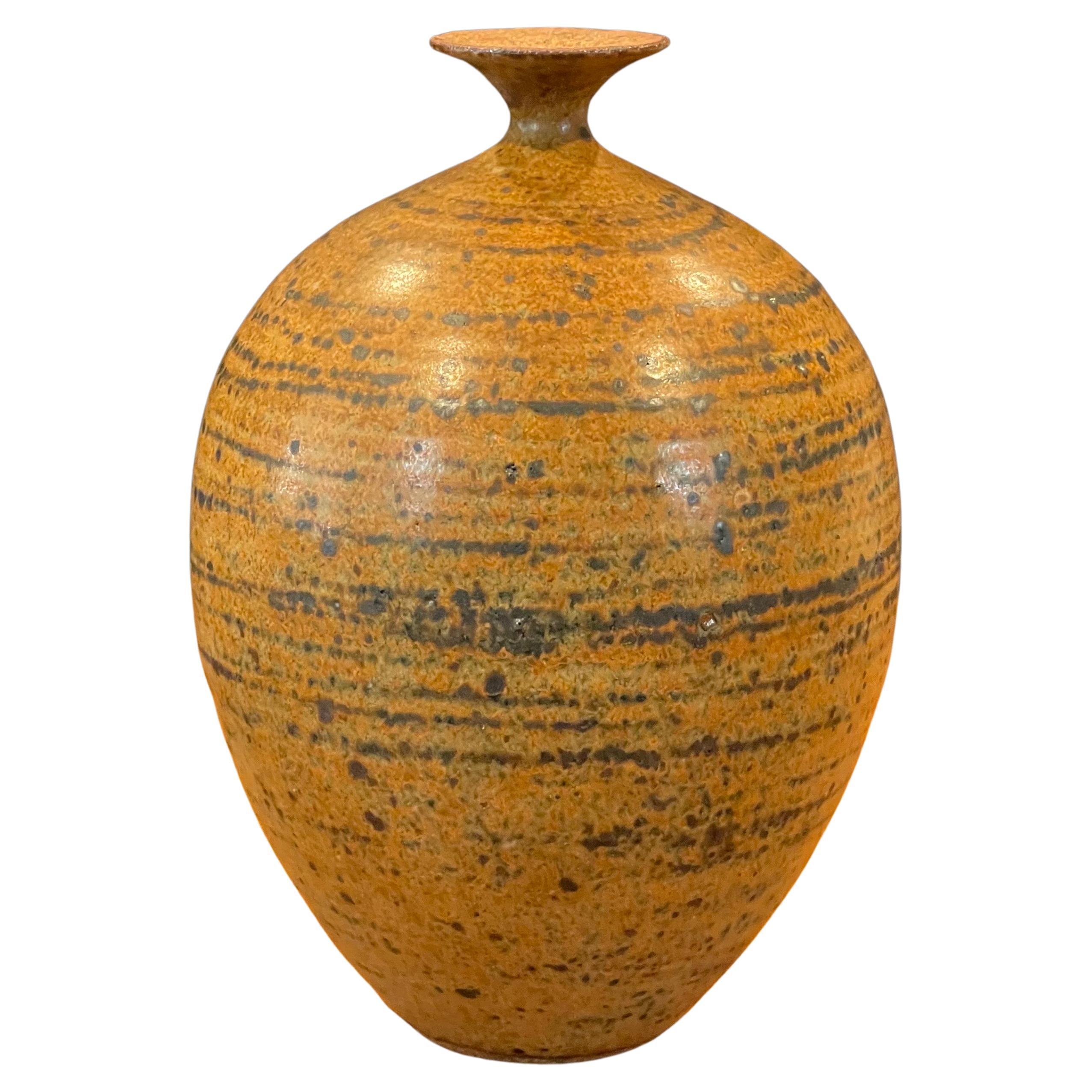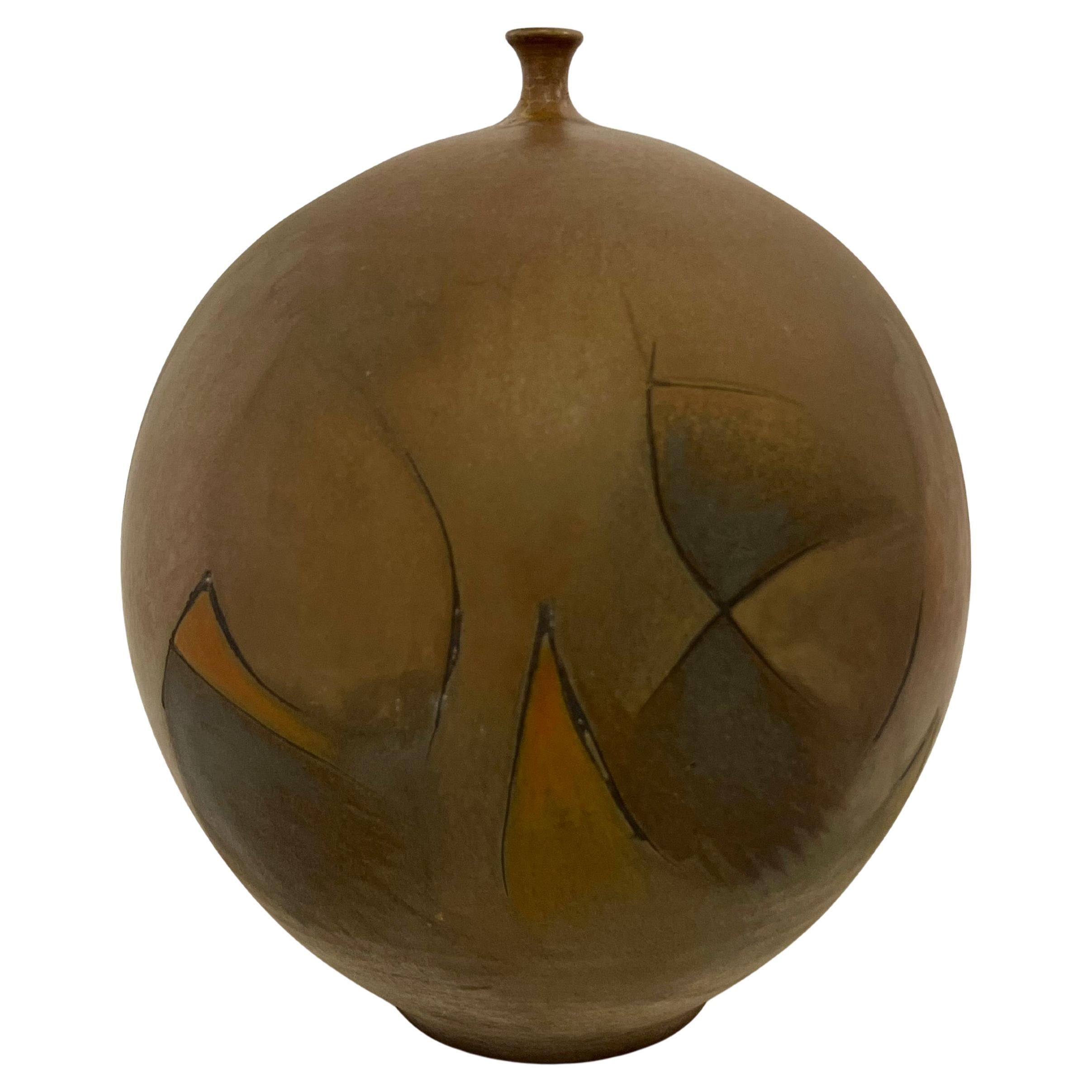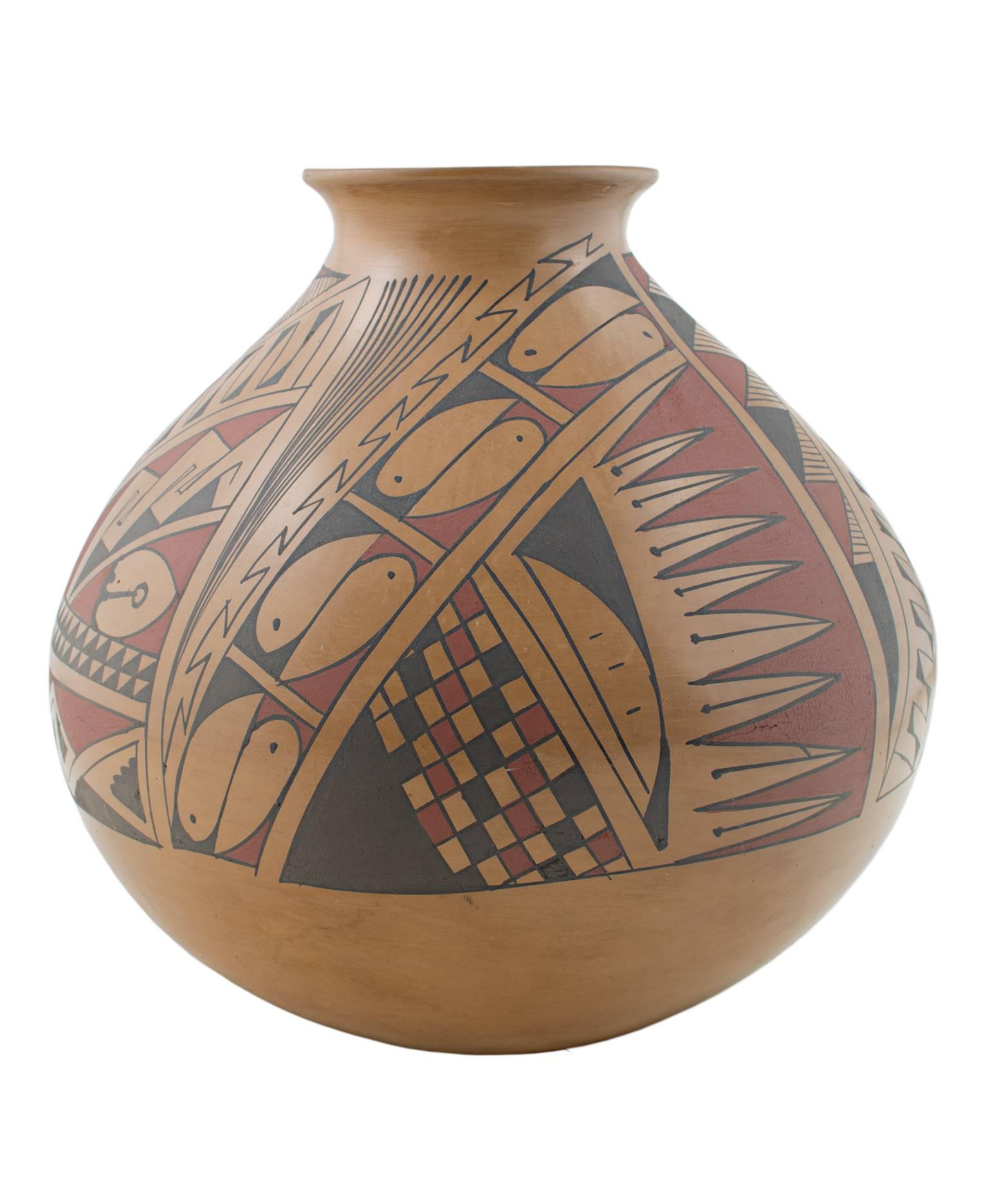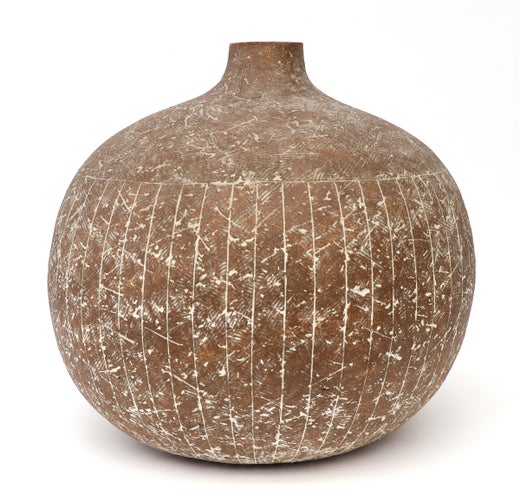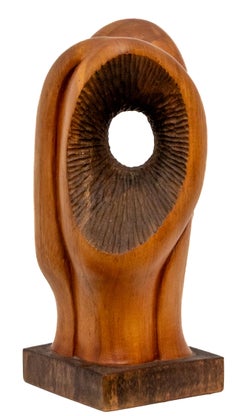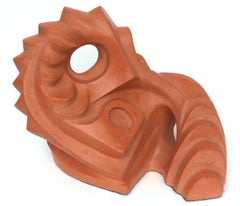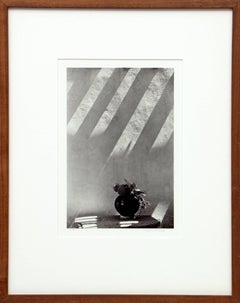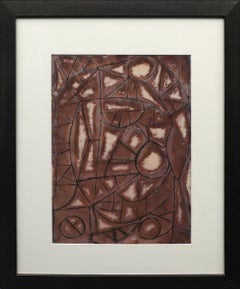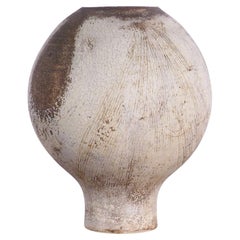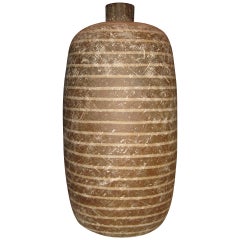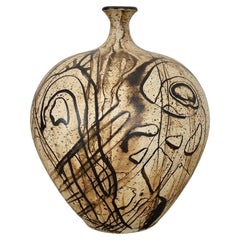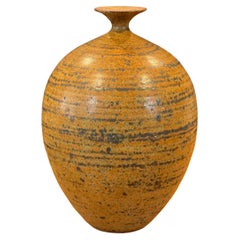Items Similar to 1960s Ceramic Pot by Claude Conover, Abstract Line Etching Design, Venel Artwork
Want more images or videos?
Request additional images or videos from the seller
1 of 14
Claude Conover1960s Ceramic Pot by Claude Conover, Abstract Line Etching Design, Venel Artworkcirca 1960's
circa 1960's
$18,250
£13,986.42
€16,074.93
CA$25,633.02
A$28,688.08
CHF 15,017.19
MX$348,508.17
NOK 190,680.09
SEK 179,939.24
DKK 119,947.24
About the Item
This exceptional 1960s ceramic pot by acclaimed 20th-century artist Claude Conover (1907-1994) features striking white parallel lines and intricate abstract etchings, making it a standout example of mid-century modern ceramic artistry. The pot, titled "Venel" and signed by Conover on the base, showcases his signature style of combining smooth and textured surfaces. Its elegant design, characterized by a narrow opening at the top, reflects Conover’s mastery in abstract ceramics and craftsmanship.
Measuring 16 inches in height and 16 inches in diameter, this ceramic vessel makes a bold and captivating statement in any collection. It remains in very good vintage condition and has been carefully preserved. For more detailed information on its condition, please feel free to contact us.
Provenance: Private Collection
About the Artist: Claude Conover was a distinguished commercial designer before fully dedicating himself to ceramics in the 1960s. Renowned for his hand-built stoneware pots, Conover’s work blends smooth, polished surfaces with textured patterns, often in off-white tones. His creations have been exhibited in prestigious museums and galleries across the U.S. and internationally. A prominent figure in the Cleveland School, Conover played a key role in positioning Cleveland as a leader in the modern art movement. In recognition of his artistic contributions, he was awarded the Cleveland Arts Prize in 1983.
Claude Conover worked for 30 years as a commercial designer before turning to ceramics. By the 1960s he was devoting himself full time to his pots. He exhibited in 14 May Shows; all told his work was shown in 47 exhibitions at museums and arts centers around the country, some traveling internationally. Many regional patrons have made these hand-built stoneware pots -most off-white-some rough, some smooth, part of their home environment. Conover is considered a member of the Cleveland School; a term first coined by Elrick Davis in a 1928 article for the Cleveland Press, titled "Cleveland's Art Pioneers Have Put City in Front Rank in Creative Field." He was the recipient of the Cleveland Arts Prize in 1983.
About the Seller
5.0
Gold Seller
Premium sellers maintaining a 4.3+ rating and 24-hour response times
Established in 1979
1stDibs seller since 2013
291 sales on 1stDibs
Typical response time: 11 hours
- ShippingRetrieving quote...Shipping from: Denver, CO
- Return Policy
Authenticity Guarantee
In the unlikely event there’s an issue with an item’s authenticity, contact us within 1 year for a full refund. DetailsMoney-Back Guarantee
If your item is not as described, is damaged in transit, or does not arrive, contact us within 7 days for a full refund. Details24-Hour Cancellation
You have a 24-hour grace period in which to reconsider your purchase, with no questions asked.Vetted Professional Sellers
Our world-class sellers must adhere to strict standards for service and quality, maintaining the integrity of our listings.Price-Match Guarantee
If you find that a seller listed the same item for a lower price elsewhere, we’ll match it.Trusted Global Delivery
Our best-in-class carrier network provides specialized shipping options worldwide, including custom delivery.More From This Seller
View AllMidcentury Modern Biomorphic Carved Wood Sculpture, Table Top Abstract Art
By Edward Chavez
Located in Denver, CO
Striking mid-20th century abstract biomorphic sculpture by American artist Eduardo Chavez, expertly carved from what is likely cherry wood. This vintage piece showcases smooth, flowi...
Category
Mid-20th Century Abstract Abstract Sculptures
Materials
Wood
Sushe Felix “Continuum” Abstract Terra Cotta Sculpture, Organic Modern, Signed
By Sushe Felix
Located in Denver, CO
Continuum is a captivating abstract terra cotta sculpture by contemporary American artist Sushe Felix, known for her fluid forms and organic modernist sensibility. This original cera...
Category
20th Century Abstract Abstract Sculptures
Materials
Ceramic
Southwestern Still Life Photo by Myron Wood, O’Keeffe’s Abiquiú Home, 1980
By Myron Wood
Located in Denver, CO
This striking vintage black and white Southwestern still life photograph was captured in 1980 by acclaimed American photographer Myron Wood (1921–1999). Rich in cultural and historic...
Category
20th Century American Modern Black and White Photography
Materials
Photographic Paper
Original 1940s Abstract Pen & Ink Drawing “The Chicken” by Edward Marecak
By Edward Marecak
Located in Denver, CO
This striking original pen and ink drawing, titled “The Chicken”, was created by celebrated 20th-century American modernist Edward Marecak (1919–1993) in the 1940s. A powerful exampl...
Category
1940s Abstract Geometric Abstract Drawings and Watercolors
Materials
Paper, Ink
1960s Mid Century Modern Abstract Bronze Sculpture on Wooden Base Stand - Chama
By Edward Arcenio Chavez
Located in Denver, CO
Mid-Century Modern Bronze Sculpture "Chama" by Eduardo Arcenio Chavez (1917-1995), circa 1966, elegantly presented on a wooden base. The sculpture measures 7 ¼ inches in height, 10 inches in width, and 3 ¼ inches in depth, showcasing Chavez’s unique style and mastery in bronze casting.
About the Artist: Eduardo Chavez...
Category
1960s Abstract Abstract Sculptures
Materials
Bronze
Modern Abstract Bronze Sculpture by Edward Chavez, Mounted on Granite Base
By Edward Arcenio Chavez
Located in Denver, CO
This captivating mid-20th-century abstract bronze sculpture by Edward (Eduardo) Arcenio Chavez (1917–1995) beautifully exemplifies his dynamic sculptural style. Cast in bronze and mo...
Category
20th Century American Modern Abstract Sculptures
Materials
Granite, Bronze
You May Also Like
Hans Coper, Early Stoneware Globular Pot, circa 1953, sgraffito incised, signed
By Hans Coper
Located in Wargrave, Berkshire
Hans Coper (1920-1981)
Early Stoneware Globular Pot, circa 1953
layered white slips over sgraffito incised and textured body
impressed seal mark to underside
25.5cm high, 21cm diamet...
Category
Vintage 1950s British Mid-Century Modern Vases
Materials
Stoneware
23” Claude Conover "Okot" Pottery Vassel
By Claude Conover
Located in Water Mill, NY
Claude Conover 23" Mid-Century Modern large pottery vassel signed and titled "Okot" on base.
Category
Vintage 1960s American Mid-Century Modern Vases
Materials
Pottery
Abstract Ceramic Studio Pottery Vase by Gerhard Liebenthron, Germany, 1980s
By Gerhard Liebenthron
Located in Kirchlengern, DE
Article:
Ceramic stoneware object
Designer and producer:
Gerhard Liebenthron
Information:
Gerhard Liebenthron, Bremen
1925 †2005
Decade:
1970s
This original vintage Studio...
Category
Late 20th Century German Mid-Century Modern Vases
Materials
Ceramic, Pottery, Stoneware
California Design Stoneware Weed Pot / Vase by Wayne Chapman
By Wayne Chapman
Located in San Diego, CA
An absolutely stunning California design stoneware weed pot / vase by noted San Diego, CA potter Wayne Chapman, circa 1970. The pot is in very good vinta...
Category
Mid-20th Century North American Mid-Century Modern Vases
Materials
Pottery, Stoneware
$680 Sale Price
20% Off
Ceramic Vase by Edgardo Abbozzo
By Edgardo Abbozzo
Located in New York, NY
Ceramic Vase by Edgardo Abbozzo, Italy, 1965.
In the early 1970s Edgardo Abbozzo assumed the role of director of the Art Institute of Florence and in 1973, after having obtained the ...
Category
Mid-20th Century Italian Mid-Century Modern Vases
Materials
Ceramic
"Casas Grandes Pottery, " a Ceramic Pot signed with Benito Morass
By Benito Morass
Located in Milwaukee, WI
"Casas Grandes Pottery" is a signed hand-built ceramic vessel with slip glaze created by Benito Morass. It features an abstract geometric design ...
Category
1990s Abstract Geometric Sculptures
Materials
Ceramic, Slip, Glaze
More Ways To Browse
Vintage Ceramic Pots
White Ceramic Pots
Geometric Wood Sculpture
Gold Penguin
Giant Pop Art Sculpture
Glass Balloon Sculpture
Fritz Indian
Granite Outdoor Sculptures
Garden Totem
Glass Bag Sculpture
Gold Rat
Gold Giraffe Sculpture
Glass Sculpture Chihuly
Gold Raven
Funhouse Mirror
Goldfish Glass
Anatomical Heart
Barye Tiger Bronze
